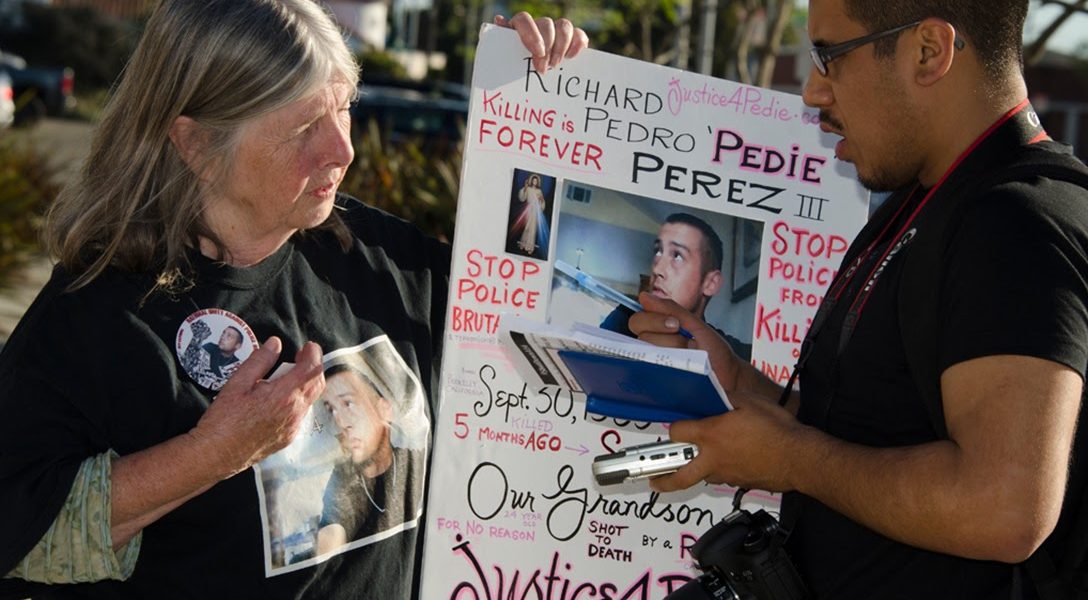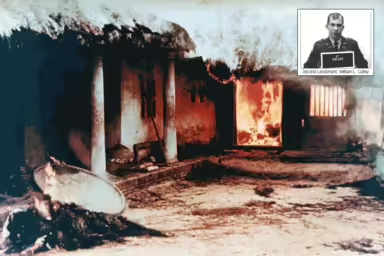Second of a three-part series on deaths at the hands of police in Tucson, AZ, and Richmond, CA.
This is Part 2 of a three-part series. Read Part 1 here.
Like flashbulbs detonating, three bursts of light illuminate the interior of a store in Richmond, CA, accompanied by the sound of three gunshots in quick succession. Pedie Perez stumbles inside through the doorway, bleeding profusely from his torso. He lurches a few steps down an aisle and collapses to the floor, sprawling face upward.
It is approximately 1 a.m. on September 14, 2014. It will be more than six hours before the coroner’s van arrives to pick up his body. It will be more than four years before an investigation into the shooting by a police officer concludes there was no reason Perez had to die.
The Richmond case has several things in common with another in-custody police killing, in Tucson, AZ, in 2019. (See Part I of this series). Both were eventually found to be unjustified. Both occurred under the same police chief: Chris Magnus.
Richard “Pedie” Pedro Perez III was a hard working 24-year-old, a former swimmer on his high school team, and the third generation to work in his family’s business.
“Pedie was very strong and very helpful to me,” said his father, Rick. “With my son working, it was making him more mature, making him more responsible. He was very unselfish, a very good person, and very responsive to the neighborhood.”
Police say they were called to the store based on some kind of disturbance, but this is in dispute. A local news reporter who interviewed the store clerk, an eyewitness to the killing of Perez, disputes the police accounting of the events and claimed he was never even interviewed by officers because he didn’t speak English and the investigators at the scene did not utilize a translator.
But within hours of the shooting, Magnus issued a statement blaming the suspect, saying he had attacked police Officer Wallace Jensen before being shot:
One of our patrol officers … was doing foot patrol at Uncle Sam’s Liquor Store. … The officer directed the suspect to sit on the sidewalk so he could conduct a records check. The suspect resisted being detained and attacked the officer when the officer tried to physically control him.
During this fight, the suspect became increasingly aggressive and tried to disarm the officer by attempting to pull the gun out of the officer’s holster. The officer unsuccessfully tried to control the suspect and repeatedly directed him to submit to the detention. The officer and the suspect fell to the ground as they grappled with each other. The suspect grabbed and held on to one of the officer’s hands, while using his other hand to simultaneously go for the officer’s gun. This was seen by at least one independent witness.
As the officer tried to retreat, the suspect continued his assault. The physically exhausted officer, fearing the suspect would overpower him and get his gun, fired three shots at the suspect, striking him in the chest. The suspect succumbed to his injuries at the scene.
“He was already conveying the message to the media in less than eight hours that my son tried to reach for the cop’s weapon, and he was a criminal,” said Perez. “He tried to demonize my son.”
Magnus had a successful track record in a decade-long run as Richmond police chief, despite a racial discrimination lawsuit by Black officers that was rejected by a jury in 2012. Richmond had been noted for gang violence, but in 2014 the city reported only 11 homicides for the whole year — its lowest number since 1971. Perez believes Magnus used his credibility as a reformer to cover for police crimes, including the death of his son. “Chief Magnus is more concerned about his reputation, and about protecting the blue brotherhood, than protecting the community from police violence,” he said.
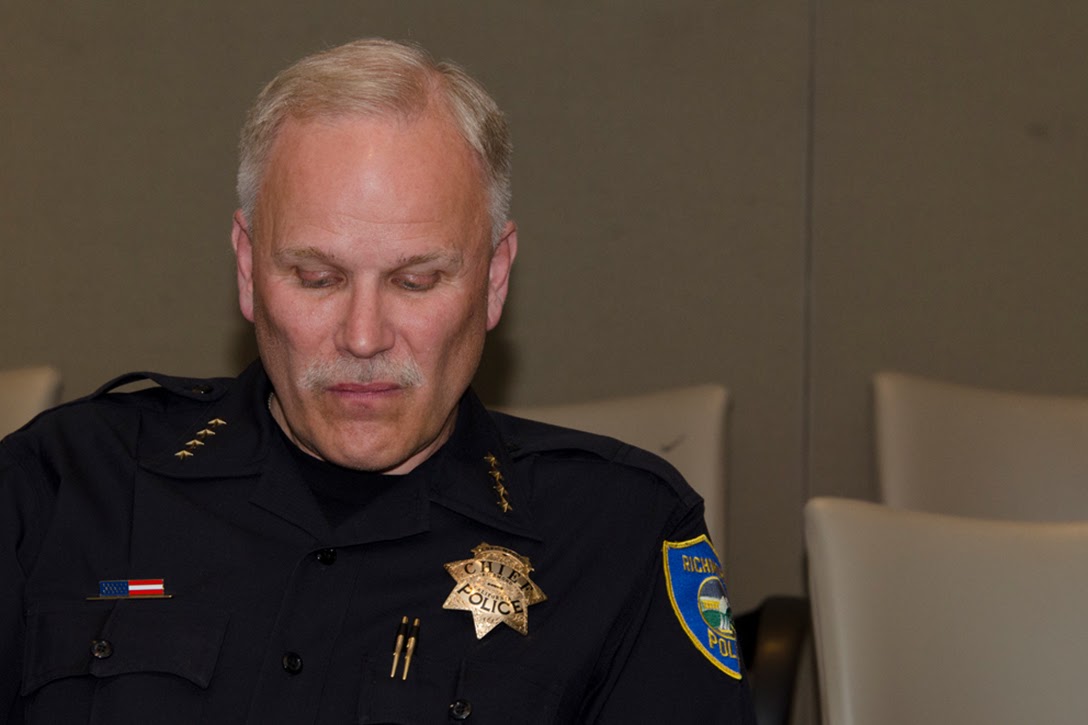
Four months later, Contra Costa County District Attorney Mark Peterson’s office released a report that exonerated Jensen. “The evidence indicates that Officer Jensen believed that he was faced with the choice of using his weapon against Mr. Perez, or having Mr. Perez use it against him,” the report said, concluding: “The officer acted in lawful self-defense. Based on our review, we believe the officer’s actions constitute justifiable homicide.”
Three years later, it was the prosecutor himself whose conduct was found to be unlawful; on June 19, 2017, Peterson was charged with 13 felonies related to illegal use of campaign funds. “He was Contra Costa County’s district attorney — until Wednesday,’’ the San Francisco Chronicle reported, adding that Peterson was accused of “using his campaign fund as if it were a personal bank account. … Peterson made approximately 600 expenditures from the political account for his personal use.”
Peterson cut a deal with state prosecutors, who allowed him to plead no contest to a single felony count of perjury, for filing false statements on campaign disclosure forms. The state dropped the other 12 charges in exchange for his resignation as district attorney. Peterson was sentenced to just 250 hours of community service and three years of probation.
More than six years after Perez’s death, defiant protest banners still ring the work yard of the family recycling business. Perez’s father, Rick, says passersby will often stop to take selfies next to the signs, like the one depicting a Richmond police car under a headline that proclaims, “Justice For Pedie, Jail Killer Cops.”
The Bay Area has a long tradition of community organizing against racist police violence, dating back to the founding of the Black Panthers in 1966. More recently, the Oscar Grant Committee Against Police Brutality and State Repression has actively campaigned for police accountability. Oscar Grant was a 22-year-old African American in 2009, the father of a four-year-old daughter, when he was shot in the back by a Bay Area Rapid Transit police officer on the platform of an Oakland train station. Grant was unarmed, lying face down with his hands behind his back, when he was killed.
The Oscar Grant Committee offered its support to the family of Pedie Perez in 2014. Together, they launched a tenacious community-led investigation and grassroots mobilization that continues to this day. The effort to hold violent police in Richmond accountable became part of the national movement now known as Black Lives Matter.
“Our investigation started in 2015,” said Gerald Smith, a veteran activist with the Oscar Grant Committee. “We went into the community, into the Kennedy Houses, and literally knocked on doors with pictures of Pedie and a leaflet, asking people if they had seen anything. By the end of the day we had six witnesses and two tapes of what had happened.”
Roll the next tape, from eyewitnesses:
Narrator: All we want is the truth, because when we read the police chief’s report, he says that Pedie attacked the officer.
Witness 1: I was bringing Pedie out the store, bringing him to my house. The police were parked on the side. I got to the corner. The police told me and my grandson to “go the f— home.” He told Pedie, “You bring your ass around the corner.” He made Pedie sit down on the ground ‘cause I didn’t leave.
Witness 2: When I was getting out of the car, we thought it was people fighting. So when we got out to look, the policeman was beating on him, on Pedie.
Witness 3 (via a translator): The officer tackled Pedie and he put him down.
Witness 2: Pedie was on his stomach. He was face down on the ground.
Witness 3 (via a translator): Pedie was yelling from pain.
Witness 3: Yeah… he was screaming, maybe three or four, five times.
Witness 3 (via a translator): So right after the officer allowed Pedie to get up halfway, he gives him a bear hug and starts squeezing him up.
Witness 4: I’m walking past him and I’m looking down at him at the same time. And he’s telling Pedie to stop resisting, stop resisting. All of a sudden I see the officer back up, and I heard the gunshots, boom, boom, boom.
Witness 2: Pedie got himself up, and then he was backing. And then the police reached for his gun. And he was like, put his hands up. He said, “Don’t shoot me, don’t shoot me.” And he shot him, like 3 times.
Witness 4: I see Pedie. He was coming in the store and he was holding his chest. He’s, “Oh man, oh man.” He looked at me, and I looked at him. He dropped to the ground no more than four feet away from me. And he looked at me. That boy never moved again.
Witness 1: Pedie was in the store laying down bleeding. I was trying to get in the store. The police put the gun in my face and told me if I didn’t back the f— up, I’d be laying right down with him.
Narrator: At any point that you were able to see, did you see Pedie try to take the cop’s gun from him?
Witness 2: No, his hands were up.
Narrator: His hands were up and he said, “Please don’t shoot”?
Witness 2: Yeah, “Please don’t shoot.”
Narrator: At any point did you see Pedie put his hands on Officer Jensen’s gun? What about when they were wrestling on the ground?
Witness 2: No, no.
Witness 3 (via a translator): There were no mis-acts or misbehave by Pedie, trying to reach for the officer’s gun in any way.
Witness 1: I don’t understand why he stopped us at all… because I was bringing Pedie home. So what made him stop us at all?
Smith said the community investigation directly contradicted police findings into the shooting. “One, Pedie never, ever, reached for Wallace Jensen’s gun,” Smith said. “Pedie was walking away from Wallace Jensen. That may have been illegal if you’re being detained. Pedie just said, ‘f— this,’ and walked away. Well, that may not be legal, OK? But Wallace Jensen tackled Pedie.
“And this is a liquor store that people are going in and out of. Numerous people saw it. And you know how people gather around when there’s something that looks like a fight. So many, many, people saw this. So, we took these witnesses, and we taped their testimony, and we put it on YouTube. And we took these witnesses to the City Council meeting in Richmond in our effort to persuade the Richmond Progressive Alliance [another local grassroots organization] that we were telling the truth.”
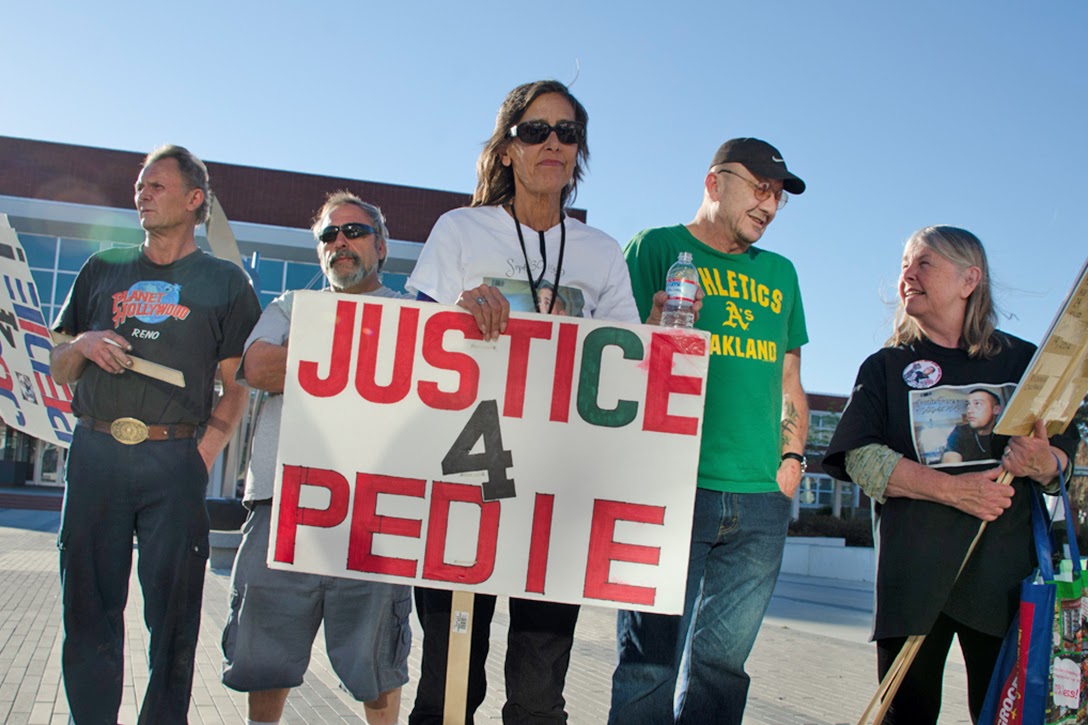
Julie Perez was standing atop a bench with a bullhorn in her hand when police approached. It was September 25, 2015, a year after her son was killed. They ordered her to switch off the sound system and forced the demonstrators across the street, so dignitaries at the Richmond Civic Center were shielded from the sights and sounds of their protest. Inside, US Attorney General Loretta Lynch was lauding Chief Magnus, thrusting him into the national spotlight for “developing positive relationships with the community.”
A few months later, after a lawsuit by the Perez family against the city of Richmond was settled, Julie Perez would say, “We’re not demonizing the police, they’re demonizing themselves. They’re not being held accountable for what they’ve done. … And that’s something we’re seeing across the nation.”
“The City Council crafted a law so that there could be an independent investigation,” said Smith. Indeed, the Richmond independent police review board was inspired by the actions the community had taken in support of the Perez family and its investigation of the police.
“Richmond is the only city that has this law,” said Smith. “Other cities need it. If there is a shooting by the police, the police harm a citizen, there will be an independent investigation. So, the Citizens Police Review Commission hired an independent investigator [in February 2016], and he studied the [Perez] case, interviewed people, we got him witnesses… And guess what?”
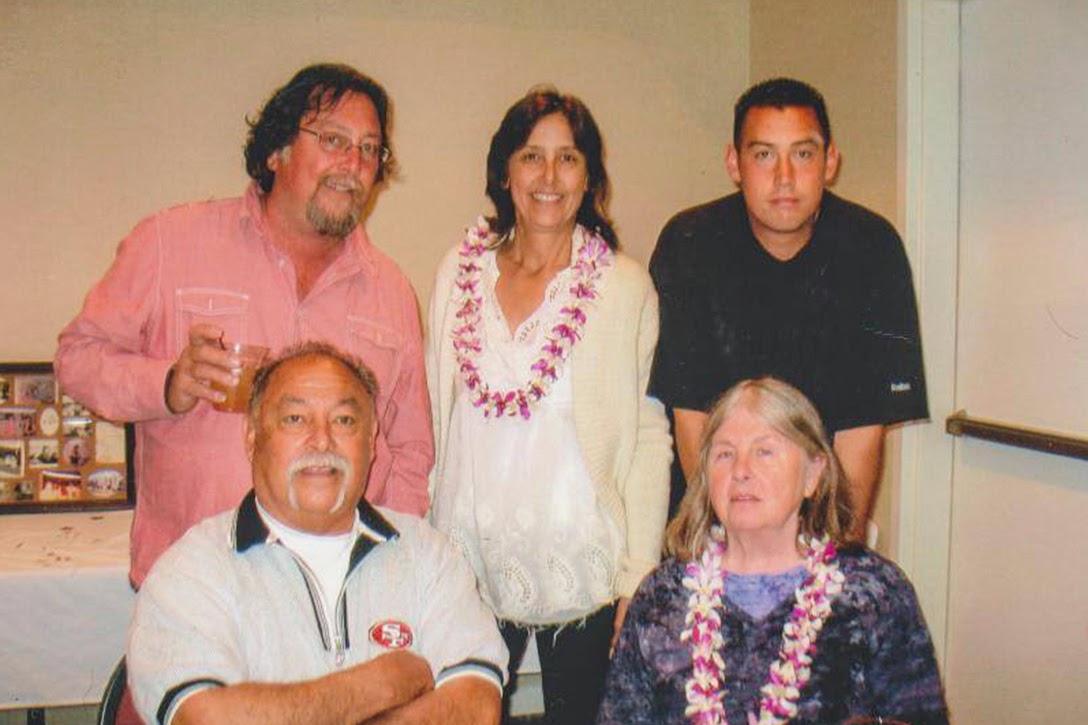
It took over two years for the investigator and review commission to conclude in April 2018 that Officer Jensen used “unnecessary or excessive force.” And it was another year and half before some details were publicly released in a case summary. David Brown, the chair of the commission, acknowledged that, “the Perez family held our feet to the fire and insisted we create a public report.” On October 2, 2019, the renamed Community Police Review Commission made its final public statement and closed out the investigative process. The heart of the statement read:
Officer Jensen confronted Mr. Perez outside the store on a public sidewalk. Perez was obviously intoxicated but did not appear to be a threat to himself or others. Mr. Perez was unarmed. Officer Jensen’s statement gave no indication that Jensen thought Perez was armed with a weapon.
Mr. Perez initially complied with Officer Jensen’s commands. He sat on the curb as instructed by Officer Jensen, and gave his name and address. On multiple occasions he stated that he wanted to go home. Mr. Perez then got up and began walking toward his home. Officer Jensen tackled him, using a “judo take-down” to knock Mr. Perez to the ground. This “take-down” was the initiation of violence and the use of force. Mr. Perez physically resisted Officer Jensen’s attempts to handcuff him. A struggle ensued, culminating in Officer Jensen firing three rounds at Mr. Perez, causing his death.
The commission found, by clear and convincing evidence, the testimony of Officer Jensen attempting to justify his use of lethal force was inconsistent with the evidence presented to the commission. Officer Jensen stated that Mr. Perez had his hand on his (Jensen’s) service handgun and was attempting to grab it from its holster. DNA analysis showed no evidence of Mr. Perez’s DNA on the gun or holster. Officer Jensen stated that Mr. Perez was charging toward him when he fired. Gunshot trajectory analysis shows that Mr. Perez was close to the ground and likely facing away from Officer Jensen when he was struck by the first bullet.
Jensen initiated physical violence directed at Mr. Perez despite Perez posing no threat to Jensen or anyone else at the scene. Jensen was unable to physically dominate Mr. Perez and escalated to shooting his gun at Mr. Perez, causing his death. Officer Jensen had lesser, nonlethal alternatives available to him that he did not employ. Conclusion: The investigator finds that there is evidence that Officer Jensen violated RPD’s Use of Force policies (300). Officer Jensen did not properly escalate his actions and his story regarding Mr. Perez lunging toward him to attack him and grab his weapon was found to be, at the least, embellished.
The victim’s father and his family believe the independent probe got much closer to the truth than any of the previous investigations, although many of the details have still not been publicly released. But their community-led investigation differed on some points, and they found additional evidence of Jensen’s culpability that was not included in the police commission’s case summary.
On the very next day after the review commission issued its statement, the Contra Costa District Attorney’s office announced there would be no prosecution:
After a thorough review involving multiple attorneys and senior inspectors, our office did not file any criminal charges against Officer Jensen. Our office can only bring charges when we believe that we can prove beyond a reasonable doubt to a jury that the officer in question committed a crime. We could not meet this high standard based on the evidence. The Review Commission has a different legal standard. We must uphold the law and adhere to the strict requirements necessary to bring a criminal case.
Rick Perez responded, “If it was the other way around, if someone killed an officer, they would insist it go to trial, and it would. I can almost forgive the officer that shot my son, but I can’t forgive the institution that tries to cover it up no matter what.”
—
Read “Fatal Errors, Part 3: Police Reformer — or Cover-Up Artist?” here.
The author of this series, Dennis J. Bernstein, is an experienced investigative journalist and host/producer of Flashpoints, syndicated on public and community radio stations across the US and Canada. Bernstein is the recipient of many awards for his work, including the 2015 Pillar Award in Broadcast Journalism, and his articles have appeared in numerous newspapers and magazines.
Ken Yale, a social justice activist and educator, contributed to the research and writing of today’s story.
Related front page panorama photo credit: Adapted by WhoWhatWhy from noematic / YouTube.
